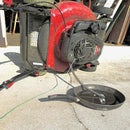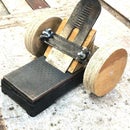Introduction: Guest Welding Hood
If you have a welder, you will have new friends who need you to weld things for them. They need to protect their eyes while you are welding and are often curious about what you are doing. But, you probably have only one welding hood. This Instructable tells how to make a hood from corrugated cardboard for your friends to use.
Step 1: Layout for Cutting
I used the side of an old cardboard box that was at least 16 inches by 16 inches. The dimensions and other details are legible from the photo. The pie-shaped pieces with the wavy lines will be removed and discarded.
Step 2: Make the Cuts
The yellow lines show the cuts to be made. The black thing is my lockback knife.
Step 3: Break the Cardboard for Folding
I placed a framing square over the fold lines where the sides or wings begin. I held it down firmly and used my other hand to crease the cardboard. Do this on all four sides of the 6 x 8 inch front section.
Step 4: Crease the Tabs
Crease the four tabs also. They will be used in gluing the hood together.
Step 5: Glue the Sides Together Using the Tabs
Pull the four sides up and glue them by folding over the tabs. Make the joints as tight as possible. Check them with a bright bulb to be certain no light gets through the joints. You may use hot glue or carpenter's glue. The hot glue hardens faster than the carpenter's glue dries. I used some packaging tape to hold the tabs down. You may need to use larger C clamps.
Step 6: How It Appears When the Joints Are Finished
You will have a box with slanted sides. These are known as hopper joints, like the hopper on a grain mill.
Step 7: Trim the Excess
Trim the pointy corners with a scissors or a knife.
Step 8: Install the Lens
Go to a local welding shop and buy a #10 shaded lens for a welding hood. The smallest size (2 x 4 1/2) works fine. If the shading is little stronger than #10, that is fine. Do not go with a much weaker lens, as for gas welding. A lens is only a couple of dollars. Align the lens 1 1/2 to 2 inches below the top fold in the cardboard and mark its outline with a pen. Cut out a hole in the cardboard for the lens.
Step 9: Make Two Cardboard Overlays to Hold the Lens
Make two cardboard frames to overlay on the lens. The opening in them should be a little smaller than the actual size of the lens. Glue one on the inside of the hood, and one on the outside of the hood. These will hold the lens in place and seal it so no light gets around the lens.
Step 10: Make a Wooden Handle
This handle is made from ordinary 2 x 2 stock. I used a spokeshave to round the bottom portion of the handle. The flat where it attaches to the front of the hood is cut at an angle so the handle angles out away from the user's chest rather than straight down. Glue the handle to the front of the hood. There will also be a screw from the inside of the hood.
The yellow arrow points to a 1/4 inch hole for hanging the hood on a finish nail in the wall.
The yellow arrow points to a 1/4 inch hole for hanging the hood on a finish nail in the wall.
Step 11: Add Reinforcement and a Screw
Cut a piece of Masonite or thin plywood to reinforce the mounting of the handle. Place it on the inside of the hood and glue it to the cardboard. Drill a hole and run a screw through the Masoninte and the hood into the handle.
Step 12: Hang It on the Wall for Storage
Here you see the finished hood hung on my workshop wall. When someone needs something welded, they really appreciate being able to watch with this extra hood.
An optional final step would be to mask the lens and paint the hood a dull black inside and out. The hood serves well without the paint, too.
Although only cardboard, this hood is more than rugged enough for its intended use.
An optional final step would be to mask the lens and paint the hood a dull black inside and out. The hood serves well without the paint, too.
Although only cardboard, this hood is more than rugged enough for its intended use.











